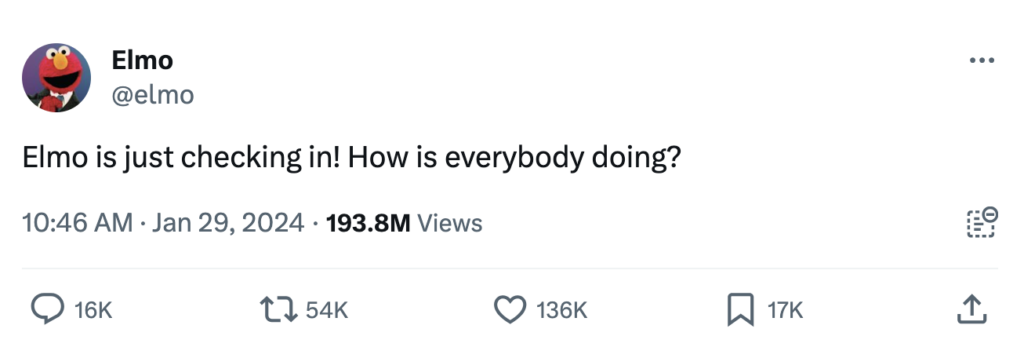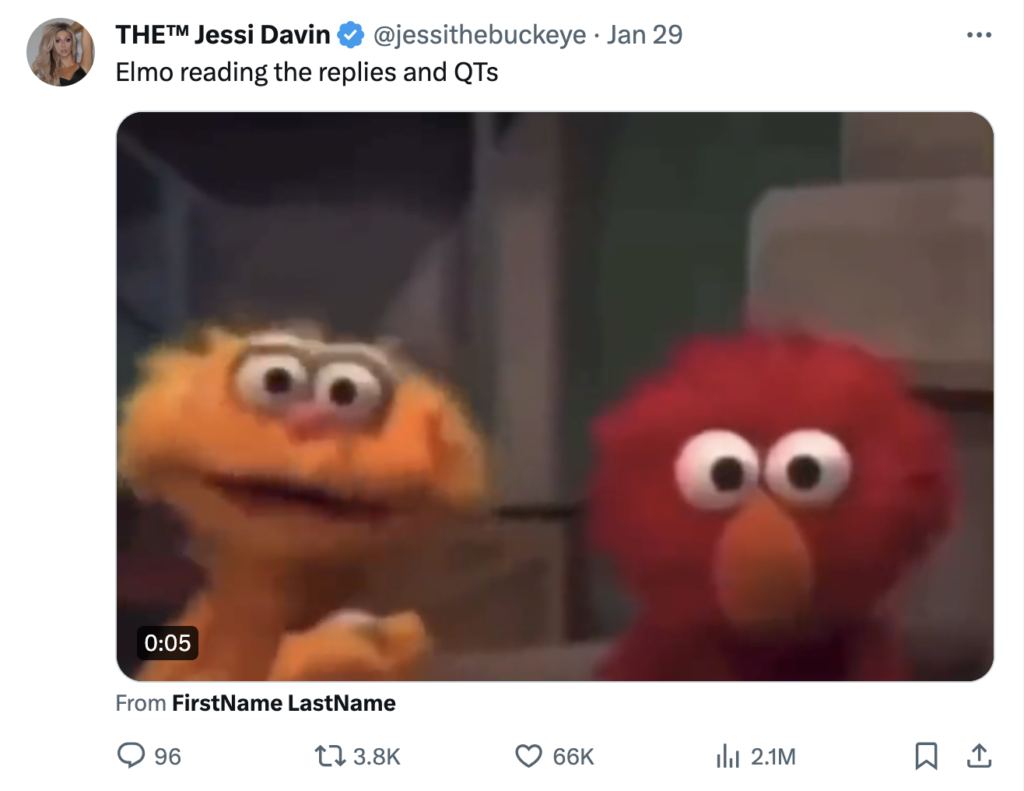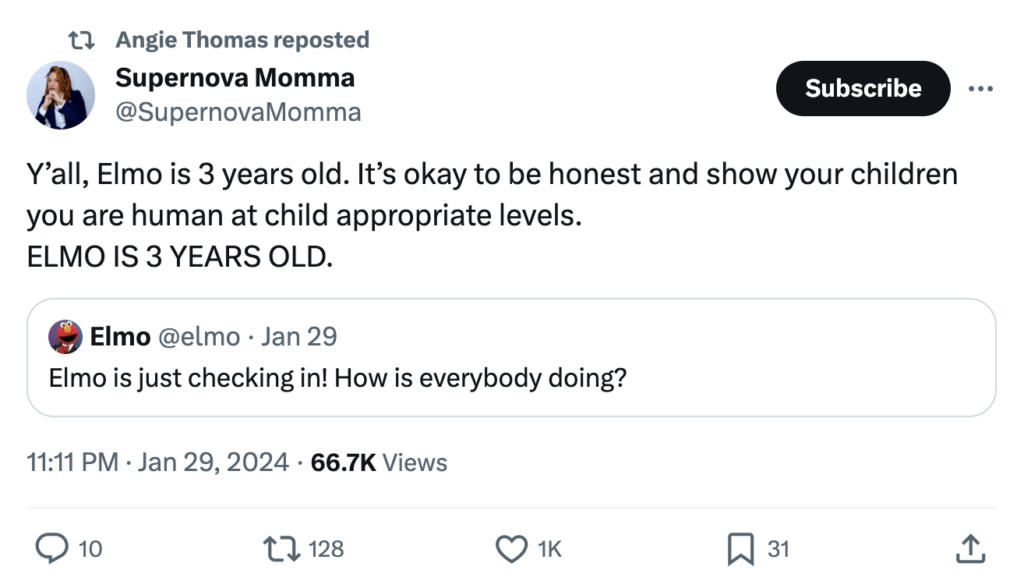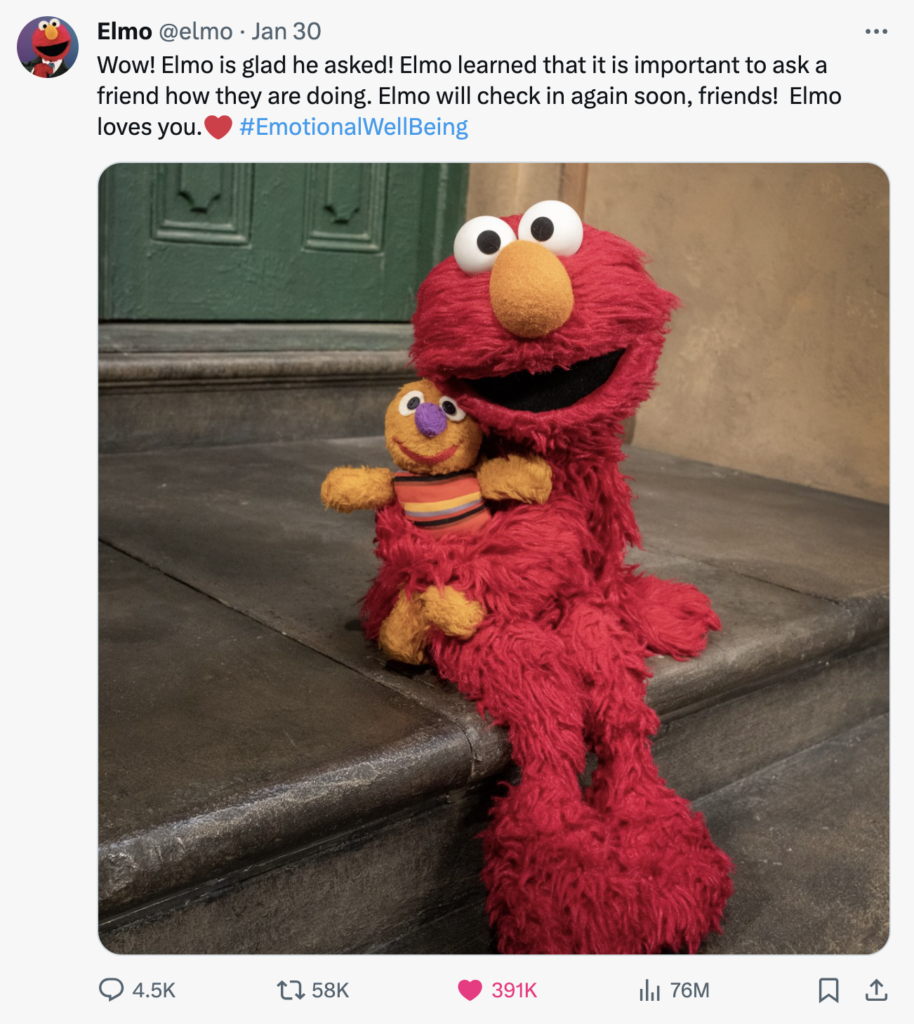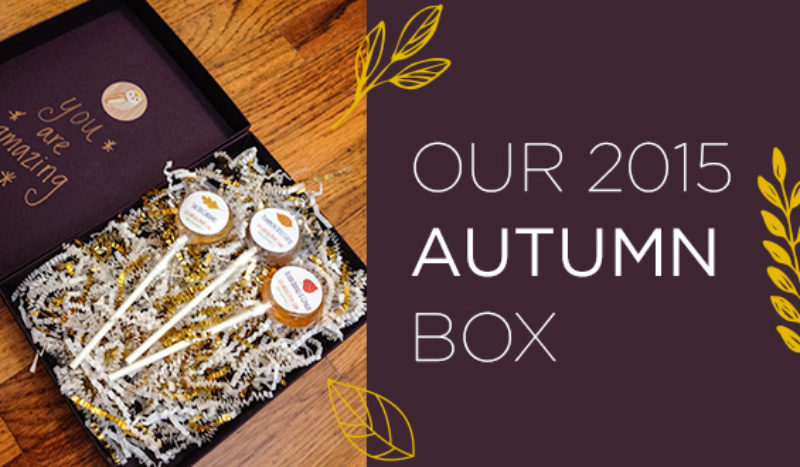On January 29th, Sesame Street’s lovable red furry friend, Elmo, asked a simple question on Twitter about how we’re all doing, and we don’t think anyone was ready for what happened next.
Okay, let’s backtrack a little bit here. Elmo is one of our favorite lovable characters from Sesame Street. Sesame Street is a long-running American educational children’s television program. It is known for its engaging and entertaining approach to teaching basic academic and social skills to children. Over the years, Sesame Street has become a cultural phenomenon and has been praised for its ability to entertain and educate generations of children. Nowadays, folks of all ages can enjoy Sesame Street characters in everyday life, because they all have Twitter accounts.
And if we’re being honest, the way these characters engage with each other and us on Twitter is quite delightful.
They stay very true to their personalities and offer good-humored laughs when they post. It’s a much-needed timeline cleanse when you look at the free-for-all that has become our social media platforms these days. And then, January 29th happened.
“Elmo is just checking in! How is everybody doing?” was a simple post paired with a smiling Elmo avatar photo. What came were 16K+ replies (at the time of this article) from people all over the world. The replies ranged from doing well, to not so great, to existential crisis. Now we know there’s a marketing and social media team behind all of these character accounts at Sesame Street. But for a moment, especially if you read the replies, we forgot that Elmo is a 3-and-a-half-year-old character.
What made this post go viral?
Seeing Elmo’s post gain traction on Twitter made us think about what it takes to make an innocent post like this go viral. It turns out, it has a lot happening in just a few short words:
- Short, Engaging Content: Posts that are interesting, entertaining, or evoke strong emotions are more likely to be shared. The beautiful thing about this post is that it resonates with a wide audience. According to Hemmingway Editor, an app that identifies how accessible your content is, Elmo’s tweet is written at a first-grade level. So not only is it simple, it’s also very accessible (and likely easy to translate into other languages, too).
- Timing: Posting at the right time significantly impacts a tweet’s visibility. This usually applies to the time of the day that you post. However, we think Elmo’s question is timely within the greater context of what’s happening in our country and in the world right now. We won’t go through the news headlines here, but we’ll say it’s likely many of us have worries tied to current events and future elections. So if someone asks how we’re doing, we have a lot to say.
- Interactivity: Encouraging interactions, such as asking questions or conducting polls, increases engagement and make your tweet more likely to be shared. This question allowed freedom of how to answer (with words, with a GIF, image, or video). And it also made it easier for people to comment on the general situation, by noting how Elmo must be feeling after seeing everyone’s response, to reminding folks that Elmo is a child and we have to be mindful of how we speak to children. This one post has taken on a life of its own.
Several factors contribute to a Twitter post going viral, though it’s important to note that virality can be somewhat unpredictable. It often has to do with striking the right cord at the right time, and a little bit of luck.
Brand Crisis or Opportunity?
A marketing/media company can look at this post from the backend and panic. They could think, “oh no! We have unleashed the floodgates!” There are no training wheels on this post and how to respond to it. At the time of this article, Elmo’s tweet had 194.5 million views, 16K replies, and 54K retweets. Is this a crisis, or is it an opportunity? Luckily, the team over at Sesame Street saw this tweet through a wider lens.
Following the tsunami of replies from the far stretches of the world to this simple question, Elmo and his friends decide to ride the wave. So Elmo follows up with a post saying “Wow! Elmo is glad he asked! Elmo learned that it is important to ask a friend how they are doing. Elmo will check in again soon, friends! Elmo loves you.” And then to top things off, several other characters from Sesame Street step in to show their support in their own way. Instantly, the campaign #EmotionalWellBeing was formed.
How to get in on the action
If you as an individual or brand want to get in on the action, you can by replying to any of these characters and using the hashtag #EmotionalWellBeing on Twitter. How can you stay true to your brand while also answering this question? This reminds us of how we often ask our clients, “If your brand was a person, who would they be?” We want you to start thinking of the character of your business because the consistency of that builds trust and integrity over time. Not ready to post a quick public reply for something like this? You can still use it as a fun icebreaker for your marketing team. Ask them how would they respond from your business account and have a conversation about it. Even NASA replied, by the way, reminding Elmo that he is made of star stuff.
What does this say about mental health and friendship?
You’ll notice in the posts featured above that Cookie Monster, Big Bird, and Oscar stay true to their personalities and true to character. And that’s how we want our friends to be, nothing but themselves as we navigate supporting each other in times of need.
Also, if we’re responding about our mental health to a 3-and-a-half-year-old character whose usual activities include counting, singing, and dancing, it might be time for us to check in with ourselves. Are there some things that we can be doing to allow ourselves the space and time to process? Do we need to be talking to someone? If you do find you need support, here are some mental health resources.
Last but not least, as Elmo noted, it is always important to ask a friend how they are doing. It’s easy to get tunnel vision as we go through life. Often, we don’t have “checking in on our friends” at the top of our list. We’re thinking maybe it’s on the list, but after doing the laundry or loading the dishwasher. Maybe Elmo’s simple post is the wake-up call we need to be more mindful. To reach out to the people who matter with a friendly “Hello, how are you?” Let’s start there.
